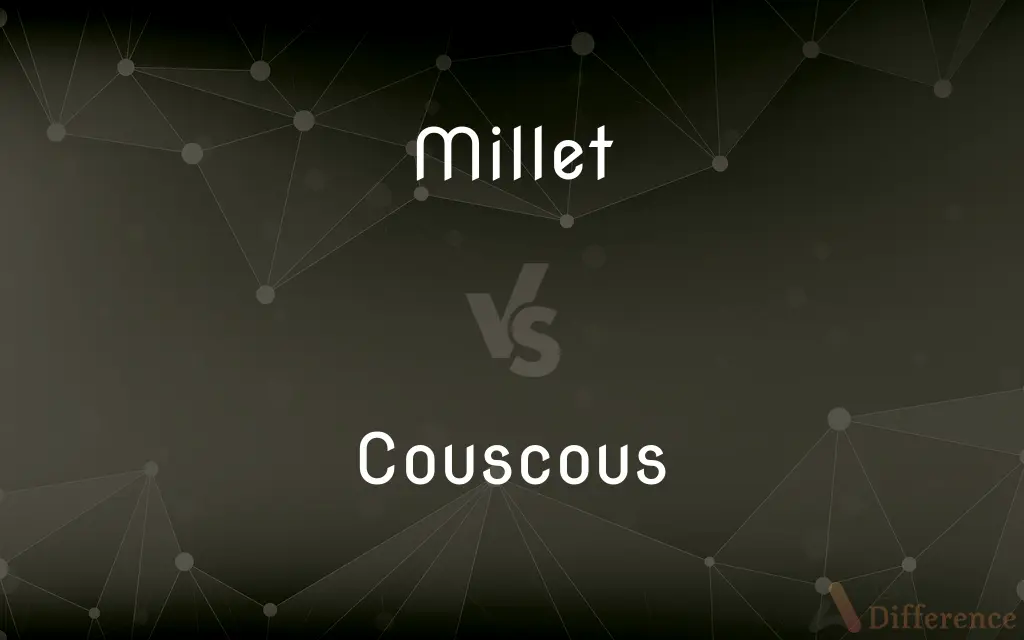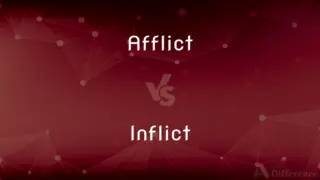Millet vs. Couscous — What's the Difference?
By Tayyaba Rehman & Maham Liaqat — Updated on April 19, 2024
Millet is a whole grain with several varieties, offering a gluten-free option, while couscous, typically made from semolina wheat, contains gluten and has a lighter, fluffier texture.

Difference Between Millet and Couscous
Table of Contents
ADVERTISEMENT
Key Differences
Millet is a versatile, ancient whole grain grown globally, rich in nutrients and naturally gluten-free. Whereas couscous is a North African staple made primarily from semolina or durum wheat, and it is not gluten-free.
Millet can be cooked to have a fluffy or creamy consistency, making it suitable for a variety of dishes from porridge to salads. On the other hand, couscous cooks very quickly by just adding boiling water, resulting in a light and fluffy texture ideal for salads and as a side dish.
Millet contains a higher fiber content, which is beneficial for digestive health. While couscous tends to have a lower fiber content but is often enriched with nutrients during its manufacturing process.
Millet has a slightly nutty flavor and can be used in both sweet and savory dishes. Whereas couscous has a mild taste, which makes it a great base for flavor absorption from spices, herbs, and sauces.
Millet is seen in traditional cuisines across Asia and Africa, highlighting its adaptability and importance in various cultural dishes. Couscous, meanwhile, is quintessential to North African cuisine, particularly in Moroccan, Algerian, and Tunisian dishes.
ADVERTISEMENT
Comparison Chart
Type
Whole grain
Pasta (granular semolina)
Gluten Content
Gluten-free
Contains gluten
Cooking Time
Longer, varies by type
Quick, usually just 5 minutes
Flavor
Nutty, earthy
Mild, neutral
Dietary Fiber
Higher, good for digestion
Lower, but enriched with nutrients
Compare with Definitions
Millet
Can be cooked to various textures.
For a creamy texture, simmer millet slowly in water.
Couscous
A North African staple made from semolina wheat.
Couscous is a common side dish in Moroccan cuisine.
Millet
A group of small-seeded grains widely cultivated around the world.
Millet is often used as a staple in many drought-prone regions.
Couscous
Used primarily in savory dishes.
Couscous is excellent with stewed meats and vegetables.
Millet
Gluten-free and rich in proteins and fiber.
Millet is a popular choice for those following a gluten-free diet.
Couscous
Quick and easy to prepare.
Couscous can be ready to eat just by adding boiling water and letting it sit covered.
Millet
Used in traditional dishes across various cultures.
In India, millet is used to make rotis.
Couscous
Absorbs flavors well.
Couscous often absorbs the flavors of the spices and herbs it is cooked with.
Millet
Adaptable in both sweet and savory recipes.
Millet porridge can be sweetened with honey and fruits.
Couscous
Often served as a base or side dish.
Couscous complements many dishes due to its light and fluffy texture.
Millet
Millets () are a group of highly variable small-seeded grasses, widely grown around the world as cereal crops or grains for fodder and human food. Millets are important crops in the semiarid tropics of Asia and Africa (especially in India, Mali, Nigeria, and Niger), with 97% of millet production in developing countries.
Couscous
Couscous is a North African dish of small (about 3 millimetres (0.12 in) in diameter) steamed balls of crushed durum wheat semolina that is traditionally served with a stew spooned on top. Pearl millet and sorghum, especially in the Sahel, and other cereals can be cooked in a similar way and the resulting dishes are also sometimes called couscous.
Millet
A cereal grown in warm countries and regions with poor soils, bearing a large crop of small seeds which are chiefly used to make flour.
Couscous
A pasta of North African origin made of semolina or other grains, formed into small pellets and usually steamed.
Millet
Any of various annual grasses with small grains that are harvested for food, livestock feed, and birdseed, especially proso millet.
Couscous
A North African dish consisting of this pasta served with stewed vegetables or meat.
Millet
The grains of any of these plants.
Couscous
A pasta of North African origin made of crushed and steamed semolina.
Millet
A demographic group in the Ottoman Empire, defined in terms of religious affiliation and enjoying a degree of legal autonomy.
Couscous
A kind of food used by the natives of Western Africa, made of millet flour with flesh, and leaves of the baobab; - called also lalo.
Millet
Any of a group of various types of grass or its grains used as food, widely cultivated in the developing world.
Couscous
A spicy dish that originated in northern Africa; consists of pasta steamed with a meat and vegetable stew
Millet
(specifically) common millet, in particular Panicum miliaceum.
Couscous
A pasta made in northern Africa of crushed and steamed semolina
Millet
(historical) A semi-autonomous confessional community under the Ottoman Empire, especially a non-Muslim one.
Millet
The name of several cereal and forage grasses which bear an abundance of small roundish grains. The common millets of Germany and Southern Europe are Panicum miliaceum, and Setaria Italica.
Millet
Any of various small-grained annual cereal and forage grasses of the genera Panicum, Echinochloa, Setaria, Sorghum, and Eleusine
Millet
French painter of rural scenes (1814-1875)
Millet
Small seed of any of various annual cereal grasses especially Setaria italica
Common Curiosities
What is couscous made of?
Couscous is made from semolina flour, which is derived from durum wheat, and it involves a process of steaming and drying tiny granules.
Can millet be used in place of couscous?
While millet can substitute for couscous in terms of providing a grain base in meals, its texture and flavor will differ, offering a nuttier and heartier profile.
Are there different types of millet?
Yes, there are several types of millet, including pearl millet, foxtail millet, and finger millet, each with unique characteristics and uses in cooking.
What are the health benefits of eating millet?
Millet is high in fiber, antioxidants, and magnesium, which can help improve heart health, lower blood sugar levels, and reduce cholesterol.
Can couscous be considered a healthy food?
Couscous can be part of a healthy diet, especially when made from whole-wheat semolina, as it provides protein and essential nutrients. However, being a refined grain, it's lower in fiber compared to whole grains like millet.
What is millet?
Millet refers to a group of highly variable small-seeded grasses, widely grown around the world as cereal crops or grains for fodder and human food.
Is millet gluten-free?
Yes, millet is naturally gluten-free, making it a suitable grain choice for those with gluten sensitivities.
How do you cook couscous?
Couscous is typically prepared by adding boiling water or broth, covering it, and letting it sit to absorb the liquid and fluff up, which takes about 5 minutes.
What is the best way to incorporate couscous into a meal?
Couscous works well as a base for salads, a side dish with meats or vegetables, or in soups and stews where it can absorb flavors from other ingredients.
Is millet easy to digest?
Millet is generally easy to digest and its high fiber content aids in digestion, making it a good grain choice for people with sensitive stomachs or those who require a softer diet.
Share Your Discovery

Previous Comparison
Afflict vs. Inflict
Next Comparison
Exhibit vs. InhibitAuthor Spotlight
Written by
Tayyaba RehmanTayyaba Rehman is a distinguished writer, currently serving as a primary contributor to askdifference.com. As a researcher in semantics and etymology, Tayyaba's passion for the complexity of languages and their distinctions has found a perfect home on the platform. Tayyaba delves into the intricacies of language, distinguishing between commonly confused words and phrases, thereby providing clarity for readers worldwide.
Co-written by
Maham Liaqat















































